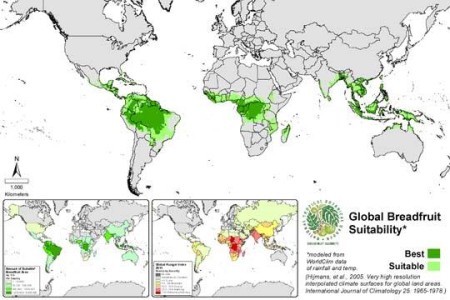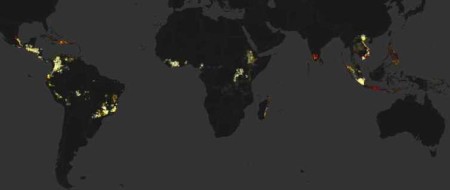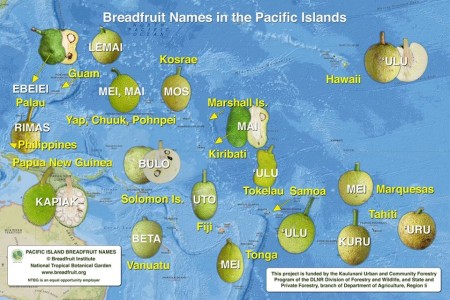- Data geeks tuck into bananas.
- Will it help the Filipino smallholder, though?
- Dietary diversity suggested as an indicator of welfare at national level. Wow.
- Seeds of Discovery discovers it has made progress.
- Celebrating a potato breeder. We should do more of that.
- Beer-fueled conservation. Not what you’re thinking.
- Milling minor millets means more money.
- CIRAD breaks down intercropping rubber. And nutmeg?
- Better forest governance by the numbers. How about savannas
- Arab region gets an environmental atlas. Also in Google Earth.
- The Pacific learns about the ITPGRFA. Not for the first time…
- I guess these guys didn’t know about MTAs.
Brainfood: Gaming landuse decisions, Natura 2000, Expressing pears, Medicinal rice, Agroforestry and conservation, Grasslands, Cotton diversity, Ancient cattle, Neolithic Balkans, Indian guar
- Gaming for smallholder participation in the design of more sustainable agricultural landscapes. Board game can be used to facilitate communal decision-making in landuse planning in the buffer zone of a Man and Biosphere Reserve. What’s not to like?
- Mixed effects of long-term conservation investment in Natura 2000 farmland. It has been good for some things, not so good for others. No word on how CWRs have fared.
- Microarray analysis of gene expression patterns during fruit development in European pear (Pyrus communis). They’re different to those of Japanese pear (Pyrus pyrifolia).
- Quantitative and molecular analyses reveal a deep genetic divergence between the ancient medicinal rice (Oryza sativa) Njavara and syntopic traditional cultivars. Njavara is a cryptic variant of traditional Kerala varieties.
- Relationships between Biodiversity and Biological Control in Agroecosystems: Current Status and Future Challenges. Management should aim to suppress pests while maintaining diversity of natural enemy guilds. Easier said than done, I suspect.
- Agroforestry and Biodiversity Conservation in Tropical Landscapes. Between agroforestry cause and conservation effect are a bunch of pesky assumptions. I wonder if gaming would help.
- Livestock grazing and biodiversity in semi-natural grasslands. It can be good. Just one paper in the proceedings of a recent major conference on grasslands.
- Genetic diversity and population structure in the US Upland cotton (Gossypium hirsutum L.). Who needs wild relatives when you have diverse obsolete varieties?
- Morphological and genetic evidence for early Holocene cattle management in northeastern China. Archaeology and DNA suggest parallel domestication of cattle in China.
- Domesticated Animals and Biodiversity: Early Agriculture at the Gates of Europe and Long-term Ecological Consequences. For thousands of years the impact of agriculture in the Balkans was limited.
- Characterization of released and elite genotypes of guar [Cyamopsis tetragonoloba (L.) Taub.] from India proves unrelated to geographical origin. And?
Nibbles: Papaya relatives, Agrobiodiversity monitoring, Orange breeding, Corn mutant, Cashew processing, Pecan pie, Communications history, Wheat research video, Agroforestry, Breeding, AG research in USA, Philippines typhoon, Eating insects, Indian blog, Open data, Microbes & wine, European databases, Afro-Indian Millet Alliance
-
As Jerry Seinfeld famously once said, I’m getting a little backed up here. Travel and work and, well, life, have conspired to keep me away from Nibbling for the past week and more, so apologies if what follows proves a little difficult to digest.
- The closest relative of the papaya looks nothing like a papaya. But will it be monitored, along with the rest of agrobiodiversity?
- We might have to look further afield than near relatives to save the orange. But closer to save corn.
- Cashews are bad? Say it ain’t so. And as for pecans…
- CGIAR comms guys (and it is all guys) reminisce about the good old days of agricultural research. And here’s an example, using wheat, of what they’re up to now. Nice shoutout for breeding and genebanks. Though of course it’s not just about the breeding.
- Crop improvement is one of six ways of feeding the world. Just. CGIAR comms guys probably on it. Barbara Schaal certainly is.
- IRRI maps rice areas affected by the recent typhoon. I did ask, and farmers there apparently mostly grow modern varieties. FAO provides more context.
- More insectivorous hijinks.
- Great new blog on chai wallahs.
- Big, open ag data will save us all. That sound you hear is the zeitgeist catching up. And the CGIAR is on it.
- You say terroir, I say microbes.
- Report on a descent into Genebank Database Hell, European Chapter. Ah, but it’s open.
- India reaches out to Africa, millets in hand.
Breadfruit Institute on a roll
They’ve been busy at the Breadfruit Institute of late. Or even more busy than usual. The director, Dr Diane Ragone, has won one of the prestigious “Star of Oceania” awards, which this year recognize
…women of and from Micronesia, Melanesia, Polynesia and the state of Hawaii who reaffirm the capacity of women to serve, lead and inspire regionally, nationally and globally through aloha, courage, perseverance, precedence and faith.
The final version of the breadfruit climate suitability map is also now online, according to a post on the Institute’s Facebook page. Here it is:
I’m not sure if we already blogged about this, but that map reminds me that WRI has a set of global water stress maps online now. Here it is for coffee.
Maybe one for breadfruit could be added sometime? Anyway, as if that weren’t enough, Diane has also put online various materials in support of a “Breadfruit and You” curriculum, including a nifty new graphic of breadfruit diversity and local names.
Our congratulations to Diane, for all of the above!
LATER: And breadfruit is not just good to eat, we also learned.
Brainfood: Cassava erosion, Chinese cereals, New banana, Olive collection, Chicken diversity, Selling nature, Japan sustainable ag & green tourism, Integrated drylands
- Maintenance of Manioc Diversity by Traditional Farmers in the State of Mato Grosso, Brazil: A 20-Year Comparison. Overall diversity unchanged, but number of varieties per farmer down. Rare varieties now common, and vice versa.
- On-farm conservation of 12 cereal crops among 15 ethnic groups in Yunnan (PR China). Higher income means fewer crops and fewer varieties. Remoteness and farm fragmentation work the other way.
- Musa arunachalensis: a new species of Musa section Rhodochlamys (Musaceae) from Arunachal Pradesh, northeastern India. It never ends.
- Identification of the Worldwide Olive Germplasm Bank of Córdoba (Spain) using SSR and morphological markers. 824 trees, 499 accessions, 332 cultivars, 200 authenticated.
- Genetic characterization and conservation priorities of chicken lines. Lose 4 of 7 chicken lines derived from the Plymouth Rock breed and you only lose a maximum of 4% of total genetic diversity.
- Conservation through Commodification? Well, maybe.
- Review of Sustainable Agriculture: Promotion, Its Challenges and Opportunities in Japan. Gotta involve the farmers. Even in Japan.
- Green Tourism in Japan: Opportunities for a GIAHS Pilot Site. Should probably be mashed up with the above. By someone other than me, though.
- An integrated agro-ecosystem and livelihood systems approach for the poor and vulnerable in dry areas. Must integrate multi-disciplinarily along the entire impact pathway. Funny though how genetic resources, which arguably lie at the source of many of these, get so little mention.


